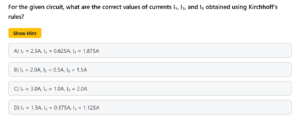Continuous Electron Drift Simulation
Electrons flow continuously through the conductor. Drag to rotate, scroll to zoom.
Example
Question:
(a) In Example 3.1, the electron drift speed is estimated to be only a few mm/s for currents in the range of a few amperes? How then is current established almost the instant a circuit is closed?
(b) The electron drift arises due to the force experienced by electrons in the electric field inside the conductor. But force should cause acceleration. Why then do electrons acquire a steady average drift speed?
(c) If the electron drift speed is so small, and the electron’s charge is small, how can we still obtain large amounts of current in a conductor?
(d) When electrons drift in a metal from lower to higher potential, does it mean that all the ‘free’ electrons of the metal are moving in the same direction?
(e) Are the paths of electrons straight lines between successive collisions (with the positive ions of the metal) in the (i) absence of electric field, (ii) presence of electric field?
Solution:
(a) Electric field is established throughout the circuit, almost instantly (at the speed of light), causing at every point a local electron drift. Establishment of current does not require electrons to travel end-to-end in the wire, though current takes a little while to reach its steady value.
(b) Each free electron does accelerate, increasing drift speed until collision with a positive ion, then slows down after the collision but starts accelerating again; thus on average, electrons acquire only a drift speed.
(c) Because the electron number density is enormous, about \(10^{29}\,\text{m}^{-3}\), so total current can be large despite slow drift speeds.
(d) No. The drift velocity is superposed on large random thermal velocities of electrons.
(e) In absence of electric field, paths are straight; in its presence, electron paths are generally curved.



